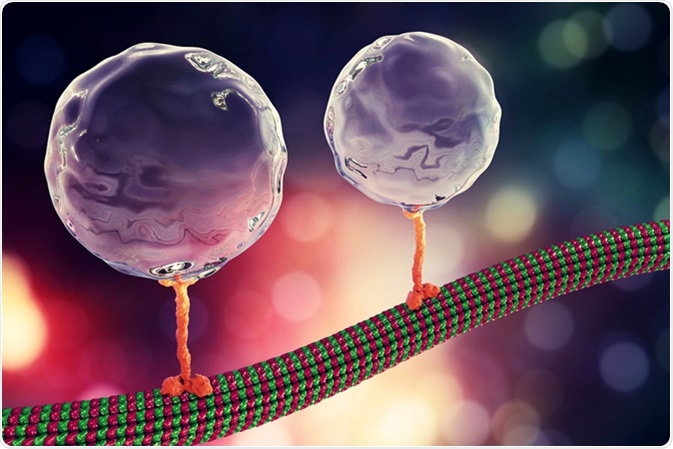What is Kinesin?

Kinesins are biological motor proteins that are ATP-dependent and function to assist cells with the transport of molecules along microtubules. Simply put, these proteins, function as highways within cells as they allow for the transport of all sorts of cellular cargo.

They play pivotal roles in mitosis (i.e. cell division) and in the trafficking of vesicles and organelles within the cell.
These cellular workhorses were discovered in 1985. Most of them transport their cargo in an anterograde fashion that flows towards the positive end of the microtubule, which means from the center of the cell to its periphery.
This contrasts with dynein, which is another member of the of cytoskeletal motor protein family that transports its cargo towards the minus end of the microtubule.
Structurally, kinesin exists as a heterotetramer that is composed of two heavy and two light chains.
The catalytic motor of kinesin, also referred to as the head, are components of the heavy chains. This head allows for the molecule to travel along the microtubule without the complication of detaching.
This is crucial, because if detachment were to occur, the cellular cargo would be lost via diffusion. The head is then connected to a linker neck region that is short and necessary for directing the path of cargo movement. Following this region is an area that is a coiled, where the light chains are connected.
These serve to bind the cargo and regulate the motor activity of the heavy chains.
Functions of Kinesin
Kinesin plays an essential role in vesicle and organelle transport. It transfers vesicles to the presynaptic axonal regions in order for the mediation of synaptic transmission to occur. Kinesin cargo, however, is not just limited to the transfer of vesicles.
Studies show that it is capable of transporting a diverse range of cargo, including but not limited to, mitochondria, lysosomes, adaptor and receptor proteins, as well as proteins that are involved in signaling-pathway interactions.
In addition to this, the importance of kinesin is underscored by the serious medical consequences, such as diseases like Parkinson’s, Alzheimer’s and Huntington’s, which appear to implicate kinesin’s interactions with disease-associated proteins.
In further essential functioning, kinesin is necessary during cell division for the assembly of spindles, separation of centrosomes and attachment of chromosomes to spindles.
Further studies postulate that kinesin may play a further role in providing tension inside the cell for kinetochore fibers, as well as disassembling kinetochores and driving the movement of poleward chromosomes via microtubule de-polymerization in anaphase.
These functions highlight the importance and serve as potential evidence that kinesin in an integral operative during mitosis and meiosis.
Sources
- http://pdb101.rcsb.org/motm/64
- https://www.sciencedirect.com/science/article/pii/S016748890000015X
- https://onlinelibrary.wiley.com/doi/pdf/10.1002/bies.950070406
- https://www.ncbi.nlm.nih.gov/books/NBK22572/
Further Reading
- All Kinesin Content
Last Updated: Feb 26, 2019

Written by
Dr. Damien Jonas Wilson
Dr. Damien Jonas Wilson is a medical doctor from St. Martin in the Carribean. He was awarded his Medical Degree (MD) from the University of Zagreb Teaching Hospital. His training in general medicine and surgery compliments his degree in biomolecular engineering (BASc.Eng.) from Utrecht, the Netherlands. During this degree, he completed a dissertation in the field of oncology at the Harvard Medical School/ Massachusetts General Hospital. Dr. Wilson currently works in the UK as a medical practitioner.
Source: Read Full Article